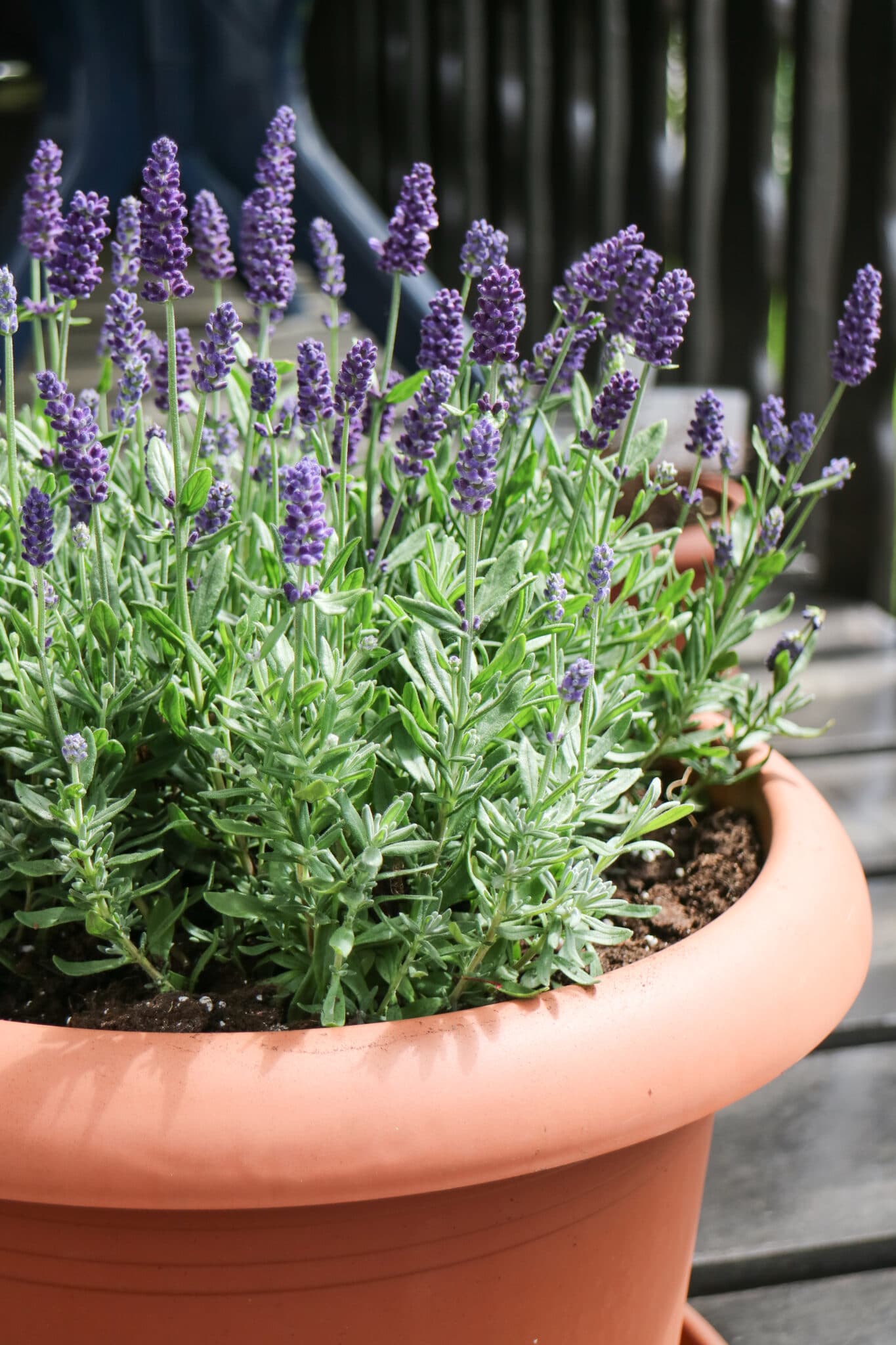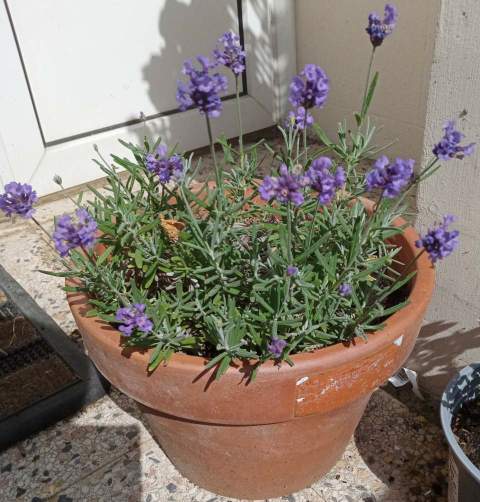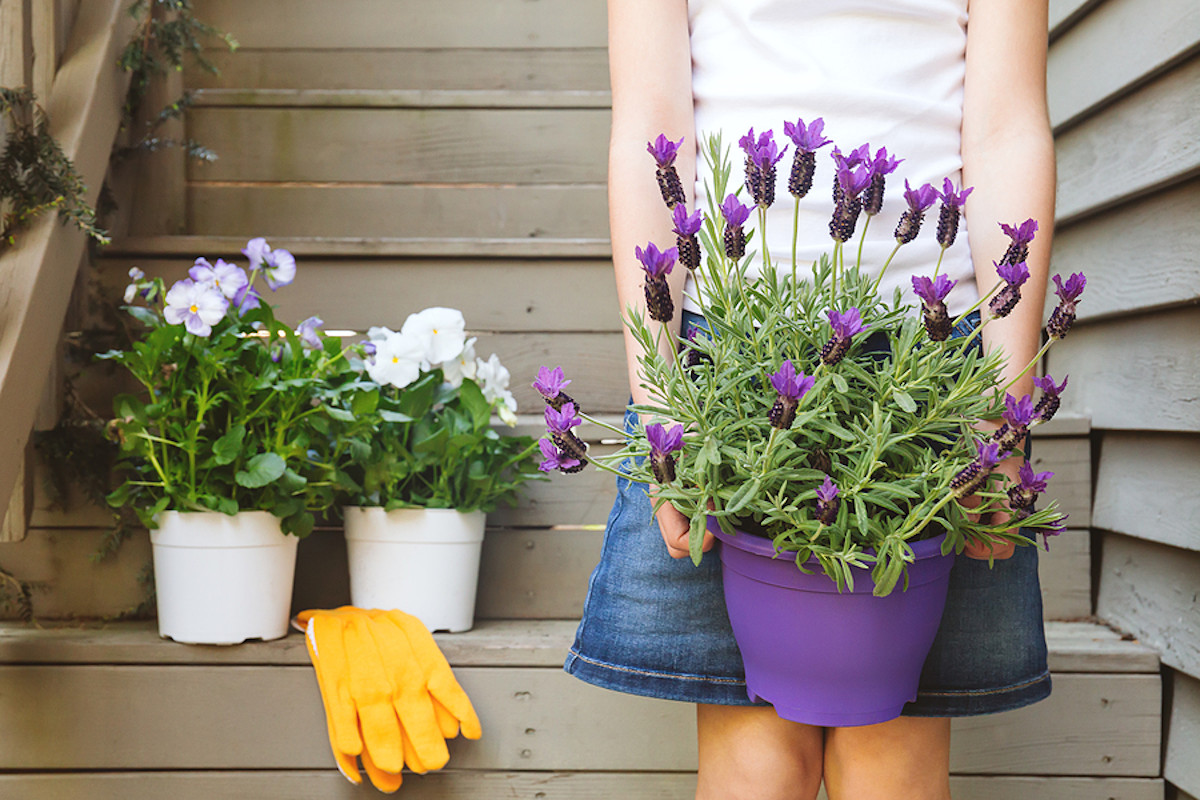As long as you mimic some of the circumstances of their natural Mediterranean home, lavenders of all kinds can flourish in pots. Potted lavenders require full light, well-drained soil with low to medium fertility, sand, and a pot with multiple drainage holes in the base to prevent the soil from becoming soggy.
Potted lavenders are a very low maintenance, high reward plant that will produce its distinct perfume and lovely flowers for several years as long as you follow a few guidelines.
If your garden has unfavorable conditions for lavenders (such as clay soil, acidic soil, or constant moisture), growing lavenders in pots is a perfect choice since you can simply reproduce or modify the conditions to suit lavenders.
To get the most out of the lavender, relocate or modify potted lavenders as needed. You have complete control over their placement and soil type.
In fact, growing plants in pots is frequently more advantageous than doing so in the ground since containers allow for better air circulation and drainage, which help to prevent fungal disease.
Read on to learn everything you need to know about the ideal potting mix, winter care, the best pot size, trimming, watering techniques, and the reasons you shouldn’t fertilize potted lavenders.
Table of Contents
Soil for Potted Lavenders
The soil needs to be well-drained, have a low fertility level, and have a pH between 6.7 and 7.5. For the best porous structure and to lower fertility, your pot should be filled with 70% compost and 30% sand or grit.
Good Soil Drainage is Essential
In their native Mediterranean region, lavenders grow in sandy or even rocky soils that have great drainage.
The roots of lavender plants benefit from quick-draining soil since it keeps them dry in between watering and raining periods. It is crucial to have dry lavender roots because they are prone to root rot when exposed to moist soil.
This implies that before planting lavenders, you will need to amend the soil in your container with either sand, grit, or perlite. Blend it in evenly with around 30% sand or grit and 70% potting soil (any type of sand or grit will be suitable).
Sand or grit will offer the ideal, porous soil texture that lavenders require to maintain their roots in good health and eventually produce their greatest summer blooms.
Your lavender may droop as a sign of stress if you only use compost because it retains too much moisture around the roots (If your lavender has a drooping or wilting appearance, take a look at my article for the solution).
Soil pH for Potted Lavenders
Lavenders may survive in soil that is either slightly acidic or moderately alkaline, as long as the pH is between 6.5 and 7.5. The majority of potting mixtures have a pH of around 7 and are therefore good for growing lavenders, although it is important to check the manufacturer’s instructions.
This indicates that you ought to refrain from using ericaceous potting soil or feed, both of which have a pH of 5.5 or lower.
You can easily amend slightly acidic compost or potting mix (below pH 6.5) by adding garden lime (affordable on Amazon), which will have clear instructions on how much to add, or by adding a dusting of wood ash. Both of these amendments will shift the soil’s pH more towards alkalinity, which is a pH level that is suitable for lavenders.
Soil Fertility (Why you Shouldn’t Add Fertilizer to Potted Lavenders)
If you want to grow lavenders with the greatest flowers and distinct smells, you should always try to replicate the Mediterranean soil conditions that they prefer.
In their natural habitat, the soil is sandy and fertile on the low to medium side. Lavender will actually grow more blossoms in low fertility soil since it prefers it.
The goal of every lavender grower is to produce blooms, but if your soil is overly fertile or you’ve added fertilizer, this will encourage plenty of foliage growth instead.
Avoid fertilizing lavender since it will get leggy, risk burning the roots, and even create growth that is deficient in oils, which are what give it its perfume.
Sand is not only helpful for drainage but also for supplying the proper level of fertility for the best flowering and fragrance. Because the sand and grit mix you need to add to the soil is low in nutrients, it should balance out potting mixes that are designed to be fertile.
Watering Potted Lavenders
Lavenders are drought-tolerant plants by nature and may survive without routine watering.
However, because their root systems are naturally more exposed to heat and sunlight in pots, lavender plants will typically require more water than lavender plants that are planted in the ground.
Potted lavenders require a little more care and attention when it comes to watering because the pots can heat up in the sun and have a drying effect on the soil.
If you live in a region with heavy rainfall, this may actually be to your advantage because potted lavender plants are less likely to spend extended periods of time in moist soil, which could damage their roots.
Lavender plants in pots require weekly watering during the first two years of growth. Once the lavender has grown, you can cut down on the watering to once every two weeks.
Use enough water to allow some water to escape via the drainage holes, indicating that the soil has received a thorough soak and has good soil drainage.
You can postpone watering for another week and wait until the soil is dry if there has been a week of heavy rain (more than 1 inch) and numerous cloudy days.
Avoid making this error. Overwatering is always a bigger issue with lavender plants than underwatering. Surprisingly, drooping foliage and browning or yellowing of the leaves are signs of overwatering.
Many individuals notice these signs, believe the soil is dry, and make the situation worse by adding additional water.
You won’t experience any issues if you follow the advised water regimen (assuming you have planted the lavenders in sandy soil). Skip watering until the soil has had a chance to dry out if you do start to notice stress symptoms, such as a drooping appearance.
For a comprehensive explanation, see my article on how to water lavender plants in pots.
Hours of Sun for Potted Lavenders
There is a correlation between the quantity of sun they receive and the number of flowers they generate, so always position potted lavenders in the sunniest region of your yard. Lavenders will still bloom with 6 or more hours of sunlight per day.
There is no variety of lavender that thrives or bears blooms in the shade. In hot nations like Spain, Italy, and France, lavender thrives in full sunlight throughout the day. However, lavender types, especially English lavenders, grow happily outdoors in colder areas as long as they receive full sunlight.
Choosing the Right Pot for Lavenders
Lavenders should be planted in pots that are at least 12 inches deep and 16 inches wide. This will be big enough to fit your lavender when it’s fully grown.
The pot must have numerous drainage holes in the base that allow water to flow freely. To prevent compacted soil in the bottom from obstructing the drainage holes, I always advise adding a 1-inch layer of gravel or stones over them.
A drip tray underneath a potted lavender plant should never be used as it will gather water. Always make sure that your water drains away freely since lavender roots cannot handle prolonged exposure to water and will start to decay very soon.
Lavenders can grow in pots made of metal, wood, clay, plastic, or any other material.
In the sun, thinner metal or plastic pots will heat up more quickly than thicker terra cotta or wooden pots, increasing soil evaporation and necessitating regular watering (once every 2 weeks).
Winter Care for Lavenders in Pots
Depending on the area where you reside, winter might provide some challenges for lavender plants grown in pots. The English lavenders (and their different hybrids) will be your best option if you reside in a place that frequently receives winter frosts because they are unquestionably the most frost tolerant lavenders.
Heavy frosts are not tolerated by the Spanish, Italian, and French varieties of lavender. You must bring these lavenders indoors throughout the winter, preferably into a greenhouse or indoors by a window, if you live in a cooler region.
The following spring, as soon as it begins to warm up again, put the lavenders back outside.
Lavenders don’t need a lot of water in the winter, but a small quantity once a month will keep them alive without damaging the roots.
If you keep your English potted lavender plants outside, they will typically get enough water without additional watering.
How Far to Space Potted Lavenders
This necessitates placing them 2-3 feet apart from other plants or humid locations. Lavenders prefer not to be in extremely exposed windy places but can tolerate some wind and sea air; in these circumstances, a natural wind break or cover, such as trees or a wall, will be appreciated.
Pruning Potted Lavenders
Pruning should always be done after late summer flowering and once again in early spring because lavenders only produce flowers on fresh growth. Pruning will keep your lavender plant in shape, prevent it from splitting and turning woody.
Lavenders can be pruned either in the ground or in containers. A visual explanation of how to prune lavenders is usually preferable; this YouTube video will teach you what to do.
Key Takeaways
- All types of lavender thrive in pots.
- Water mature lavender plants twice weekly and newly planted lavender once per week.
- Every year, prune lavender plants to promote more blooms.
- Lavenders should be grown in containers with numerous drainage holes on the bottom to avoid standing water.
- To ensure proper drainage, the soil should be made up of 70% potting mix and 30% sand or grit.
- Avoid fertilizing lavender plants because it will result in lanky growth and fewer flowers.
- Place them in a bright area.
- Between 6.5 (slightly acidic) to 7.5 (slightly alkaline), the pH of the soil must be.
- Plant lavenders 2-3 feet apart to allow for adequate airflow and the prevention of fungus.
- Compacted soil won’t affect drainage if the bottom of the pot has a 1-inch layer of gravel or stones.
FAQ
Can you grow lavender in pots outside?
Lavender in a pot needs full sun, so be sure to set the pot where there will be enough of sunshine. The sunniest southern-facing window or a grow light are the finest locations for indoor lavender plants. In your yard, make sure to include them in any areas that get at least 8 to 10 hours of direct sunlight.
How do you care for a potted lavender plant outside?
Place your lavender plants that are growing in containers somewhere that receives full light (at least eight hours per day) and give them minimal water. Between waterings, let the soil dry up, but don’t let it get to the point where the plant starts to wilt. Many types of lavender won’t survive a cold winter since they prefer heat.
Does lavender grow better in pots or ground?
Full light and proper drainage are essential for lavender. In the winter, it is more likely to die from too much moisture than from the cold. Although the plant will be more susceptible to cold temperatures than it would be in the ground, a container is a great way to promote drainage.
Does lavender like being in pots?
Additionally, lavender grows quite well in containers. It really grows better in pots in the Deep South because of the enhanced drainage and airflow. Although the plants flourish in the dry conditions of the West, they are typically regarded as annuals in the South.
How do you take care of potted lavender in the winter?
Lavenders need a chilly, but not drafty, winter climate; at night, the temperature can drop as low as 40°F (5°C), and during the day, it shouldn’t rise above 65°F (18°C). This means you should keep them away from heaters because they will dry them out and drafty windows because they can get too cold.



